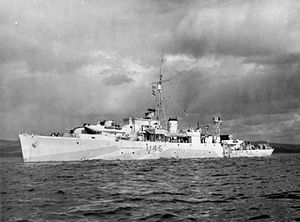| HMS Wild Goose (U45) | |
|---|---|
 HMS Wild Goose in April 1943 | |
| Career (United Kingdom) | |
| Name: | HMS Wild Goose (U45) |
| Ordered: | 13 April 1940 |
| Builder: | Yarrow Shipbuilders |
| Yard number: | 1762 |
| Laid down: | 28 January 1942 |
| Launched: | 14 October 1942 |
| Commissioned: | 11 March 1943 |
| Decommissioned: | 1955 |
| Motto: | Alert to evil |
| Honours and awards: |
Atlantic 1943-44 Biscay 1943 Normandy 1944 Arctic 1944 English Channel 1945 |
| Fate: | Scrapped 26 February 1956 |
| General characteristics | |
| Class & type: | Black Swan-class sloop |
HMS Wild Goose (U45) was a Black Swan-class sloop of the Royal Navy. She was one of several ships of that class that took part in the famous "six in one trip" in 1943 (in which six U-boats were sunk in one patrol).
She was built at Yarrow shipyards in Scotstoun, Glasgow. She was launched on 14 October 1942.
On 22 May 1943 she was deployed on her first mission along with Wren, Woodpecker, Cygnet, Starling and Kite on anti-submarine operations supporting the outward passage of Atlantic Convoy ONS8.
On 18 December 1943 she was taken in hand for repair in Liverpool, redeploying at the end of January 1944.
On 31 January 1944 she sank U-592 with Starling and Magpie and later joined the Woodpecker and Kite, taking part in the sinking of U-762 (8 February 1944), U-238 & U-734 (9 February 1944), U-424 (11 February 1944) and U-653 (15 March 1944)
At the end of May 1944 she returned to Liverpool for more repairs, whilst here she was selected to take part in Operation Neptune to prevent U-Boat attacks on the D-Day invasion convoys. On 1 July 1944 she was released from Neptune and despatched to Belfast for refit, completing in September 1944.
During February and March 1945 she was deployed to the English Channel, taking part in the sinking of U-327 by Lauban and sinking U-683 herself. Following VE day on 6 May 1945 she was nominated for transfer to the British Pacific Fleet following her second refit. By the time the refit had completed in September 1945 the Japanese had surrendered and the Wild Goose was therefore surplus to requirements and was Paid off and reduced to reserve status.
She was later recommissioned in 1946 and deployed to the Persian Gulf, spending the rest of her service career in the Middle East before finally decommissioning in 1955.
The Wild Goose was sold for breaking up in February 1956, and arrived at the breakers at Bo’ness on the Firth of Forth near Edinburgh on 26 February 1956.
Notes[]
The ships badge was 'rescued' from the breakers yard by a dock worker and taken home. His daughter, in recent times, past this onto mike Kemble for donation to a suitable source. I donated it to Liverpool National Maritime Museum and it will be going on view later this year (2013).
References[]
- Hague, Arnold (1993). Sloops: A History of the 71 Sloops Built in Britain and Australia for the British, Australian and Indian Navies 1926–1946. Kendal, England: World Ship Society. ISBN 0-905617-67-3.
External links[]
The original article can be found at HMS Wild Goose (U45) and the edit history here.